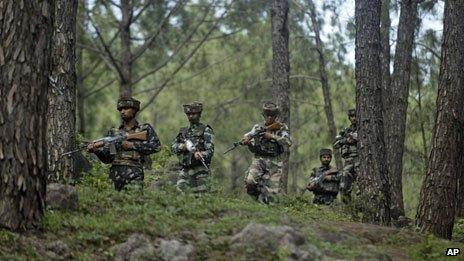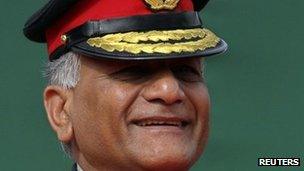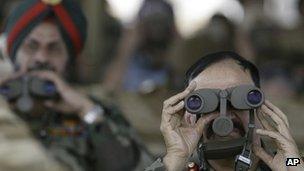General's age row threatens Indian army's modernisation
- Published

The Indian army remains handicapped by equipment shortages
Indian army chief General VK Singh has dropped his case against the government over his disputed age, but as defence analyst Rahul Bedi points out, the row highlights divisions between the armed forces and the defence ministry that threaten to derail the military's modernisation.
The legal battle over the Indian army chief's age may is over, but the ramifications of the unusual controversy will doubtlessly endure.
If not handled appropriately, the consequences of the simmering antagonism between army headquarters and the Ministry of Defence (MoD) over General VK Singh's birthday could in the immediate future adversely impinge on the force's long-delayed modernisation plans.
Defence planners in Delhi fear these widening fissures could affect efforts to replace the army's ageing Russian and Soviet equipment - an overhaul needed to augment India's regional military profile in keeping with its burgeoning economic muscle and growing ambition.
'Honour, not tenure'
Matters climaxed last week after India's Supreme Court declined to entertain Gen Singh's 16 January petition seeking a changed birth date.
This was the first time any serving Indian army chief had gone to court against the government.
Gen Singh wanted the Supreme Court to acknowledge 10 May 1951 as his birthday instead of 10 May 1950, which he maintained was recorded wrongly.
Ironically, the earlier date had formed the basis of his recent promotions to high rank, including his appointment as army chief.

Gen Singh was the first serving army chief to petition the courts against the government
The confusion over his birthday arose after it was recorded as 10 May 1951 by the adjutant general's branch - which is the army's official record keeper - but as 10 May 1950 by the military secretariat wing, responsible for promotions and postings.
Claiming to fight for "honour and not tenure", Gen Singh asked the Court to accept the later date, which is recorded as his date of birth on his birth certificate, school-leaving form and various other official documents.
If Gen Singh had prevailed he would have served another 10 months until March 2013 as the army chief, seriously upsetting the army's pyramid-like senior hierarchy and also the appointment of his successor.
The Supreme Court dismissed the general's plea and backed the MoD, which had three times rejected the army chief's demand to accept the 1951 date of birth.
The court said that since Gen Singh had wilfully accepted the earlier date as his birthday on three occasions for elevation to high rank, he could not as army chief renege now on his commitment.
The army saw the ruling a major setback for the force and the MoD took it as a victorious put down of the overbearing army.
But in reality both lost as the symbiotic trust and co-operation necessary between the two to work harmoniously to modernise and upgrade the army's depreciated equipment profile now was, at best wobbly.
Daunting challenges
Consequently, the priority for Gen Singh's successor will be to mend ties with the MoD in order to bring about the army's long-delayed transformation to enable it to face daunting challenges.

The army's modernisation programme has suffered from a lack of planning
The 1.2-million-strong army remains handicapped by severe equipment shortages, obsolete hardware and restricted night-fighting capability.
Even a cursory assessment of its ambitious armour, artillery and infantry modernisation programmes reveal them all to be in a state of flux, afflicted by delays and an overarching lack of planning and resource management.
This impairs its ability to put into operations its new "cold start" doctrine of being able to launch a pre-emptive offensive against Pakistan in a limited war scenario in order to achieve negotiable gains in a nuclear-armed region.
The doctrine requires significantly more efficient weapons systems than are currently in use. It envisages converting static army formations deployed in a defensive role along the Pakistani frontier into "integrated battle groups" capable of undertaking swift, punitive strikes with minimum re-organisation.
But the row over Gen Singh's age has imperilled the teamwork between army and defence officials needed to bring about this re-organisation.
While it is nobody's case that Gen Singh could have made good all the glaring shortfalls it is worth examining how precarious what needs to be done has now become.
A significant proportion of the army's main battle tanks and armoured vehicles lack night-fighting capability.
A long-standing proposal to acquire more than 3,000 155mm artillery pieces to replace the six calibres currently in use has been continually postponed for nearly a decade.
An ambitious plan to update by 2020 all of the army's 359 infantry battalions as well as the 66 Rashtriya Rifles paramilitary battalions deployed exclusively on counter-insurgency operations is years behind schedule.
Similarly, efforts to replace obsolete helicopters have been interminably postponed due to procurement irregularities and the issuing, withdrawing and re-issuing of tenders.

The Indian army faces daunting challenges
And though the immediate pretext for the growing rupture between the armed services on one side and the MoD and its civilian bureaucrats on the other was Gen Singh's age, animosity between the two has grown over decades.
Having always looked upon the military - particularly the army - with suspicion after independence and gazing nervously first at Pakistan's and later at Bangladesh's experience, successive administrations have constantly sought an opportunity to put the uniforms down.
Such inherent misgivings and fear of the military also manifests itself in the non-appointment of a Chief of Defence Staff (CDS), despite ministerial commissions and review and parliamentary committees stressing the need for such an officer in a nuclear-armed state and for an expanding military power with out-of-area responsibilities.
"Continually postponing the selection of a CDS is hampering not only the long overdue revamp of India's military apparatus but also unfavourably impacting management of the country's strategic command in an increasingly belligerent and nuclearised neighbourhood " said Arun Sahgal, joint director of the Institute of National Security Studies in Delhi.
The government needs to overcome its suspicion of the defence forces, he added.
Sadly the military too is not without blame.
Several military chiefs in recent years and senior officers too have actively contributed to this negative relationship by seeking political and bureaucratic patronage for career enhancement while in service and for lucrative sinecures after retirement.
The issue of Gen Singh's age has been another avoidable divide.
Rahul Bedi is based in Delhi and works as the India correspondent for Jane's Defence Weekly and the Irish Times.
- Published3 February 2012
- Published18 January 2012
- Published17 January 2012
- Published16 January 2012